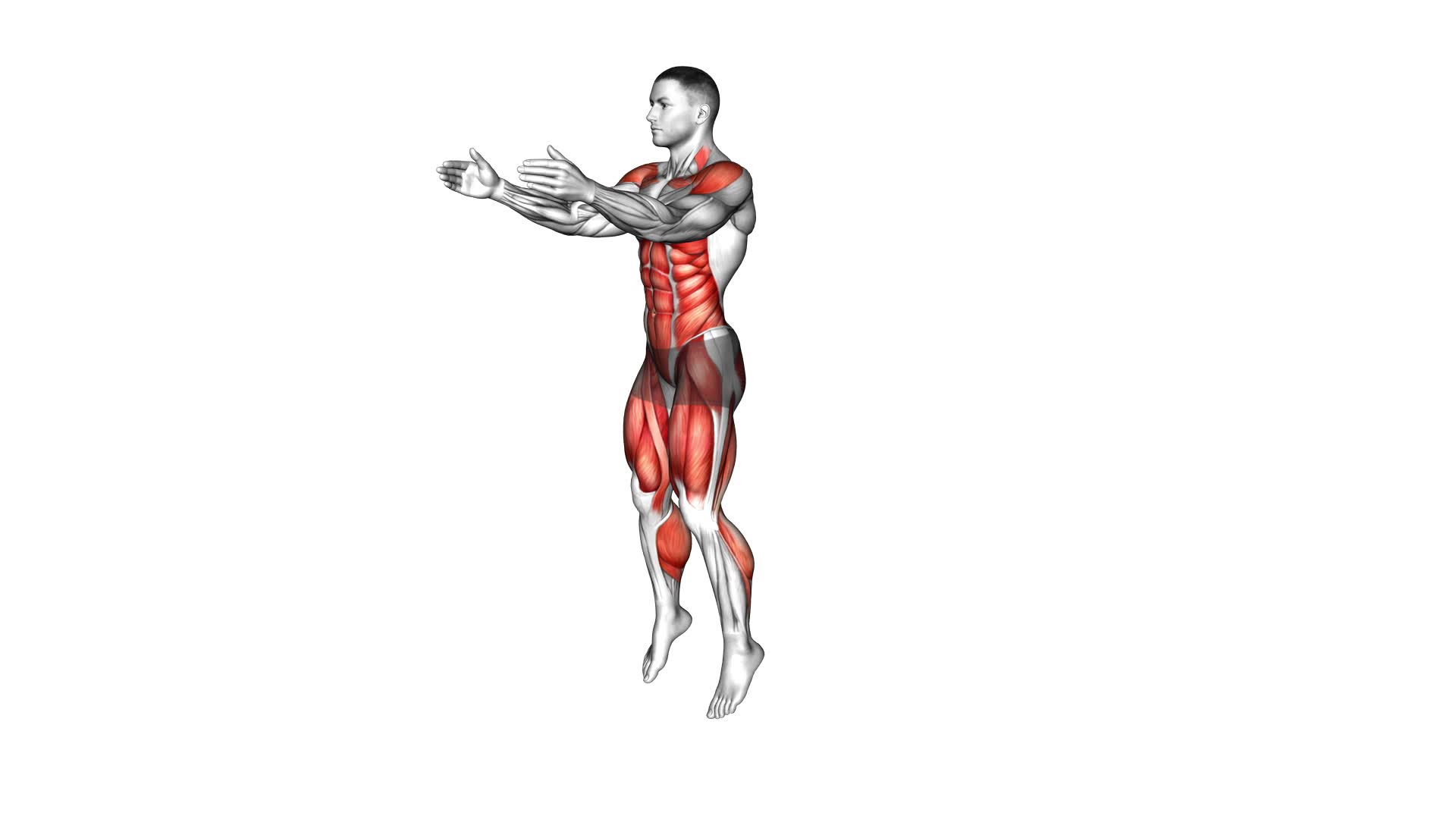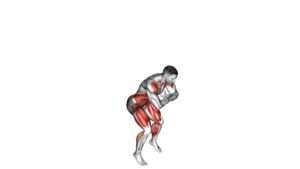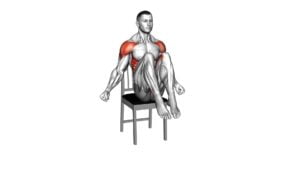Tuck Jump (VERSION 2) – Video Exercise Guide & Tips

Are you ready to take your workout to the next level? Get ready to sweat and burn calories with the Tuck Jump (Version 2).
Watch This Exercise Video
This explosive exercise targets your legs, core, and cardiovascular system.
In this video exercise guide, we'll show you the proper technique, common mistakes to avoid, and tips to increase intensity.
With our helpful tips and modifications, you'll be able to safely progress and achieve your fitness goals.
Let's jump into it!
Key Takeaways
- The tuck jump (Version 2) helps to improve vertical jump and engage multiple muscle groups.
- It increases lower body strength and power while enhancing cardiovascular fitness.
- The exercise can be incorporated into high-intensity interval training (HIIT) workouts.
- To increase intensity and progression, advanced variations, plyometric exercises, and added resistance can be included.
Benefits of the Tuck Jump (VERSION 2)
Discover the explosive benefits you can achieve by incorporating the Tuck Jump (VERSION 2) into your workout routine.
One of the primary benefits of incorporating tuck jumps into HIIT workouts is the improvement in your vertical jump. By performing this plyometric exercise, you engage multiple muscle groups, including your quadriceps, hamstrings, glutes, and calves, which are all essential for generating power during a vertical jump.
The explosive nature of the tuck jump helps to increase your lower body strength and power, allowing you to jump higher and more explosively. This can be especially beneficial for athletes involved in sports like basketball, volleyball, or track and field, where a higher vertical jump can give you a competitive edge.
Additionally, incorporating tuck jumps into your HIIT workouts can also enhance your overall cardiovascular fitness. The high-intensity nature of this exercise increases your heart rate and challenges your cardiovascular system, leading to improved endurance and stamina.
To incorporate tuck jumps into your HIIT routine, you can perform them as part of a circuit or interval training. For example, you can alternate between sets of tuck jumps and other exercises like burpees or squat jumps to create a challenging and effective workout.
Proper Technique for the Tuck Jump (Version 2)
To perform the Tuck Jump (Version 2) with proper technique, start by standing with your feet hip-width apart and your arms relaxed at your sides. Begin the movement by bending your knees and jumping up explosively. As you jump, bring your knees up towards your chest, tucking them in tightly. At the peak of your jump, try to touch your knees with your hands. Land softly by extending your legs and absorbing the impact with your muscles. Repeat the movement for the desired number of reps.
When incorporating tuck jumps into your workout routine, it's important to progress gradually and master the basic technique before attempting variations. Some tuck jump variations and progressions include increasing the height of your jump, adding a 180-degree twist in mid-air, or performing tuck jumps on an unstable surface like a bosu ball.
Tuck jumps can be a great addition to a high-intensity interval training (HIIT) workout routine. They can be used as a plyometric exercise to increase power and explosiveness. To incorporate tuck jumps into your HIIT workout, try performing them in intervals, alternating with other exercises such as burpees or jump squats. This will help elevate your heart rate and burn more calories.
Common Mistakes to Avoid During the Tuck Jump (Version 2)
Avoid these common mistakes when performing the Tuck Jump (Version 2) to ensure proper form and prevent injury.
- Lack of proper warm-up: Skipping warm-up exercises can increase the risk of muscle strains or sprains during the Tuck Jump (Version 2). Make sure to warm up your muscles with dynamic stretches and light cardio activities before attempting the exercise.
- Poor landing technique: Failing to land properly can lead to joint injuries. When landing from the jump, aim to land softly on the balls of your feet with slightly bent knees. Avoid landing with straight legs or with excessive force, as this puts unnecessary stress on your joints.
- Insufficient core engagement: Neglecting to engage your core during the Tuck Jump (Version 2) can result in improper form and reduced effectiveness. Remember to tighten your abdominal muscles and draw your belly button towards your spine throughout the exercise.
- Rushing through the movement: Performing the Tuck Jump (Version 2) too quickly can compromise your form and reduce the benefits of the exercise. Take your time and focus on maintaining proper technique, ensuring that each jump is controlled and executed with precision.
Tips to Increase Intensity and Progression of the Tuck Jump (Version 2)
To increase the intensity and progression of the Tuck Jump (Version 2), challenge yourself by incorporating advanced variations and adding resistance.
Advanced variations of the tuck jump can help you take your explosive power and strength training to the next level. One variation you can try is the single-leg tuck jump, where you perform the exercise on one leg at a time. This increases the demand on your leg muscles and improves balance and stability.
Another advanced variation is the tuck jump with a 180-degree twist. As you jump, rotate your body in mid-air and land facing the opposite direction. This adds a rotational element to the exercise and engages your core muscles.
In addition to advanced variations, you can also incorporate plyometric exercises into your routine to further increase the intensity of the tuck jump. Plyometric exercises, such as box jumps and depth jumps, involve rapid stretching and contracting of the muscles, which enhances explosive power. These exercises can be performed before or after the tuck jump to maximize your training.
To add resistance to the tuck jump, you can use ankle weights or a weighted vest. Ankle weights increase the load on your leg muscles, making them work harder during the jump. A weighted vest distributes the resistance evenly across your body, challenging your entire musculature.
Safety Precautions and Modifications for the Tuck Jump (Version 2)
Make sure you prioritize safety and consider modifications when performing the Tuck Jump (Version 2). Here are some safety precautions and modifications to keep in mind for injury prevention:
- Warm-up: Before attempting the Tuck Jump (Version 2), make sure to warm up your body with dynamic stretches and light cardio exercises. This will help prepare your muscles and reduce the risk of injury.
- Proper form: Maintain good posture throughout the exercise. Keep your core engaged, chest lifted, and shoulders relaxed. Avoid excessive arching of the back or rounding of the shoulders.
- Surface and footwear: Perform the Tuck Jump (Version 2) on a flat, non-slip surface to prevent slipping or tripping. Wear supportive athletic shoes that provide cushioning and stability.
- Modifications: If you're a beginner or have any existing knee or ankle issues, you can modify the Tuck Jump (Version 2) by reducing the height and intensity. Start with a smaller jump and gradually increase as you build strength and stability.
Frequently Asked Questions
How Many Calories Can You Burn by Doing the Tuck Jump (Version 2)?
You can burn a significant amount of calories by doing the tuck jump (version 2).
This exercise has many benefits, including improving your cardiovascular endurance and strengthening your leg muscles.
To perform a proper tuck jump, start in a standing position, then jump up, bringing your knees towards your chest and extending your arms out in front of you.
Land softly and repeat for an effective calorie-burning workout.
Can the Tuck Jump (Version 2) Help Improve My Vertical Jump?
The tuck jump (version 2) can definitely help improve your vertical jump. By incorporating this exercise into your routine, you can enhance your lower body explosiveness and power. It targets the muscles in your legs, including your quads, hamstrings, and glutes, which are key for generating upward force.
To get the most out of the tuck jump, make sure to maintain proper form by jumping as high as you can and bringing your knees up towards your chest.
Is It Necessary to Warm up Before Performing the Tuck Jump (Version 2)?
Before performing the tuck jump (version 2), it's necessary to warm up. Warming up helps prepare your muscles and joints for the intense movements involved in this exercise. It increases blood flow, raises your body temperature, and reduces the risk of injury.
To perform the tuck jump (version 2) correctly, start with a light cardio warm-up, followed by dynamic stretches. Remember to engage your core, jump explosively, and tuck your knees to your chest.
Can the Tuck Jump (Version 2) Be Performed by Individuals With Knee Problems?
Yes, you can modify the tuck jump (version 2) if you have knee problems. It's important to prioritize your safety and avoid exercises that may aggravate your knees.
Instead, consider alternative exercises that are easier on your joints, such as low-impact cardio exercises like swimming or cycling.
Always consult with a healthcare professional or a certified trainer to find the best modifications and exercises for your specific knee issues.
How Often Should I Incorporate the Tuck Jump (Version 2) Into My Workout Routine?
To effectively incorporate tuck jumps (version 2) into your workout routine, consider the benefits of plyometric exercises in a fitness routine.
These jumps can be a valuable addition to your high-intensity interval training (HIIT) workouts. By including tuck jumps regularly, you can improve explosive power, agility, and overall lower body strength.
However, it's important to start slowly and listen to your body, especially if you have knee problems. Gradually increase the frequency and intensity of tuck jumps as you build strength and stability.
Conclusion
In conclusion, the tuck jump (Version 2) is a highly effective exercise that offers numerous benefits for improving lower body strength and explosive power.
By following proper technique and avoiding common mistakes, individuals can maximize the effectiveness of this exercise.
Additionally, incorporating tips to increase intensity and progression will help to challenge the body further and promote continuous improvement.
However, it's important to prioritize safety and make any necessary modifications to accommodate individual needs or limitations.

Author
Years ago, the spark of my life’s passion ignited in my mind the moment I stepped into the local gym for the first time. The inaugural bead of perspiration, the initial endeavor, the very first surge of endorphins, and a sense of pride that washed over me post-workout marked the beginning of my deep-seated interest in strength sports, fitness, and sports nutrition. This very curiosity blossomed rapidly into a profound fascination, propelling me to earn a Master’s degree in Physical Education from the Academy of Physical Education in Krakow, followed by a Sports Manager diploma from the Jagiellonian University. My journey of growth led me to gain more specialized qualifications, such as being a certified personal trainer with a focus on sports dietetics, a lifeguard, and an instructor for wellness and corrective gymnastics. Theoretical knowledge paired seamlessly with practical experience, reinforcing my belief that the transformation of individuals under my guidance was also a reflection of my personal growth. This belief holds true even today. Each day, I strive to push the boundaries and explore new realms. These realms gently elevate me to greater heights. The unique combination of passion for my field and the continuous quest for growth fuels my drive to break new ground.







